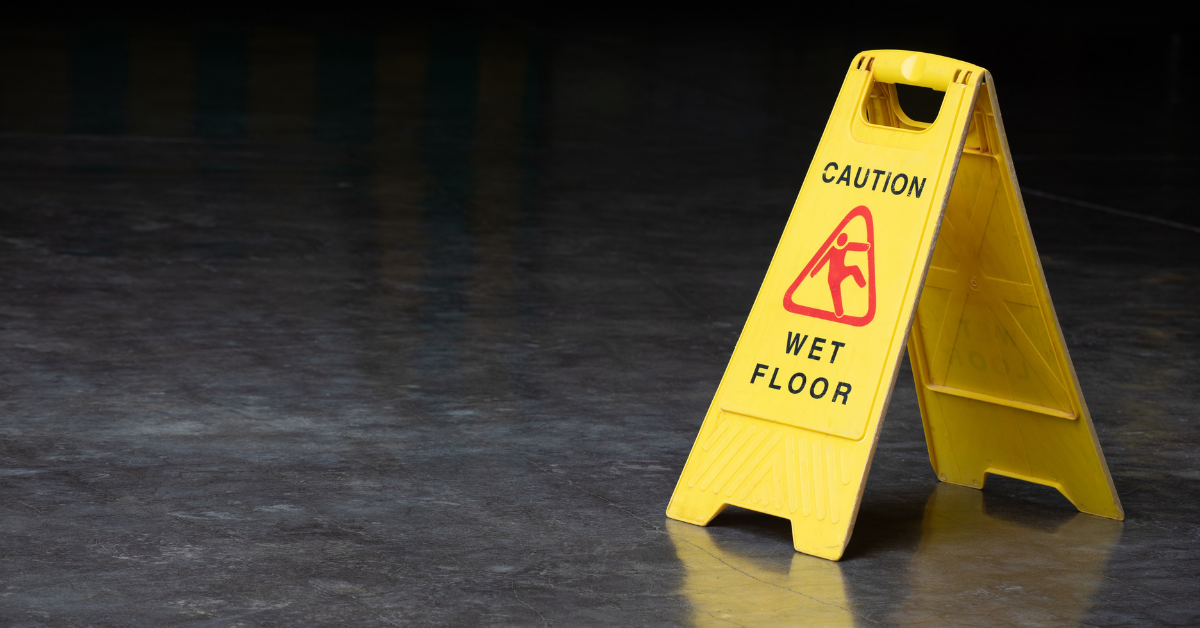Most “on the job” injuries are caused by unsafe acts or unsafe work practices. It is important to look at the types of accidents that are the result of unsafe work practices that result in the greatest costs in order to prioritize efforts that will achieve the greatest reduction in the cost of injuries.
95% of accidents that result in workers’ comp claims and amount to more than 70% to 80% or more of the cost or workers’ comp claims are caused by people not doing their job the right way, not using the right tools for their job, doing something that they aren’t trained how to do or just not using “safe work practices” in the performance of their job.
Slips, Trips, and Falls
The three most common types of “on the job” injuries can be divided into three areas. The first is “slips, trips, and falls,” which are common for jobs or tasks that require lifting, pushing, pulling, or twisting.
Slipping hazards are often the result of wet or oily surfaces which should not be allowed in the first place or should be cleaned up if surfaces become slippery due to a “spill.” Trips are generally caused by uneven work surfaces or debris in the way, and falls are generally the result of poor work practices involving elevated work surfaces, ladders, or working in and out of vehicles.
Sprains and Strains
Next is “sprains and strains,” which are generally related to material handling jobs where workers “over-exert” or do more work than their body is capable of.
These types of injuries are generally the result of workers trying to do too much or to employ “awkward postures” in the performance of their job. Trying to lift an object that weighs over 100 pounds or to place a heavy object on an elevated table or even try to reach something on a shelf that is too high can all result in strains and sprains.
Struck By and Caught Between
Lastly, there are “struck by” and/or “caught between” injuries. While manufacturing and material handling jobs often see more workers’ comp claims, injuries can just as easily happen from awkward postures in many jobs, slips and falls while coming and going from work, working outdoors in snowy or icy weather, or ergonomic issues, even in office environments.
These injuries, as the title suggests, involve workers being hit by flying objects or products moving through the facility. This can be as innocuous as someone trying to step into a space that is too small and their foot getting caught, it can be an employee being struck by a forklift, a box falling off a pallet, or material falling off of a shelf in the warehouse.
Minimizing Everyday Risk for Workers
The first step to preventing injury is to take preventative measures: evaluate the jobs and conditions in your workplace that could cause these types of injuries and then create programs to reduce the conditions that help these accidents occur in the first place. You'll want to have a plan of action based on your industry, the type of jobs your workers do, etc.
As an example, delivery truck drivers or workers that travel for their jobs, can have slips, trips, and falls outside of their place of employment, especially in the wintertime, when there can be ice and snow.
To help minimize the potential for slips and falls for these workers, a good place to start would be to make sure that traction control devices are used on the vehicles.
Workers should also be equipped with shoe cleats or such and that, as a simple safety aid, workers carry a bottle of sand with them to use on an icy driveway or walk to help keep them from falling.
It is also helpful to have customer sites that are well shoveled, plowed, sanded, and salted. We have even convinced some employers to cut down pine trees around their parking lots to allow the sun to hit the pavement and help melt ice and snow off the parking lot surface as well as sidewalks.
Uneven walkways and wet or blocked aisles in a building can also be a culprit in workers falling.
Keep Your Workplace Safe from Even the Most Common Culprits
Concerns around general workplace safety are serious and should be addressed as soon as possible.
The Lawson Group works with companies to assess the risks for these and all types of injuries in their workplaces, and create customized plans for how to reduce and, hopefully, eliminate those risks. We help schools, building managers, property owners, municipalities, construction teams, and architects keep their employees, students, residents, and stakeholders safe. Contact us to learn more.







